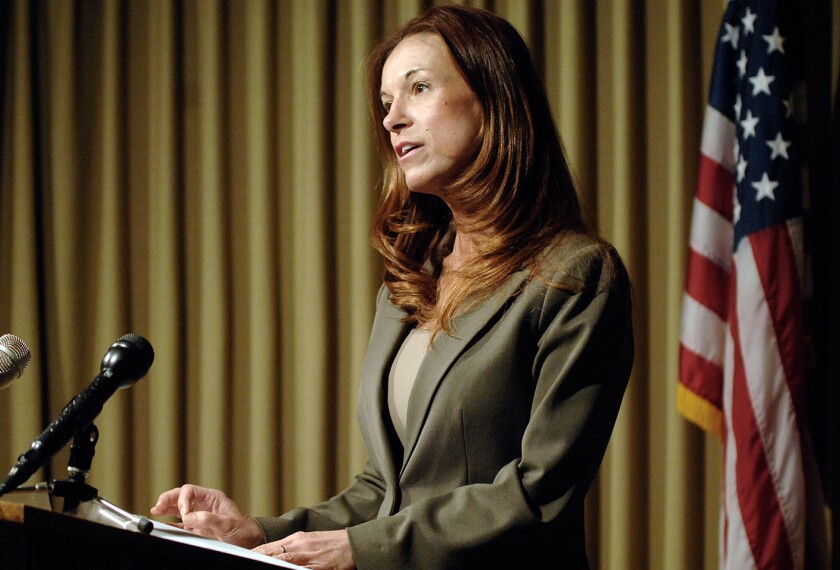President Reagan, in a move he said was designed to exemplify the importance of education in America, announced last week that an elementary- or secondary-school teacher would be the first private citizen to fly on a space-shuttle mission.
“When the shuttle lifts off, all of America will be reminded of the crucial role teachers and education play in the life of our nation,” the President said during award ceremonies here for the 262 winners of the Secondary School Recognition Program. “I can’t think of a better lesson for our children and our country.”
According to the National Aeronautics and Space Administration, which will conduct the search for the nation’s first citizenastronaut, specific qualifications and requirements for applicants for the shuttle program will be released in early October. The teacher will fly on a mission in late 1985 or early 1986 and will be expected to take a year-long leave of absence after the flight to visit schools, talk at workshops, and appear on radio and television programs.
Minimum Criteria
The space agency has already announced that, at a minimum, applicants must be full-time teachers, citizens of the United States, and free from debilitating disease. A panel of ���Ķ���vlog appointed by NASA officials will pare down the field of applicants first to about 100 and then to 10. An internal NASA selection committee will then narrow the field of applicants to five, and finally to a prime candidate and a backup.
The two teachers will then undergo eight weeks of training at the Johnson Space Flight Center in Houston.
NASA warned that it is not accepting applications at this time, adding that any applications received before “specific flight opportunities are announced” will not be accepted.
Challenge to Educators
Later in his speech, which the White House described as a “major policy address on education,” Mr. Reagan told the group of ���Ķ���vlog that schools have made some, but not enough, progress toward solving their ills. He then challenged the nation’s ���Ķ���vlog to meet four goals by the end of the 1980’s. First, he proposed that schools “should regain at least half the losses of the last 20 years” on combined Scholastic Aptitude Test scores. In 1963-64, average scores were 478 on the verbal section and 502 on the mathematics section. In 1982-83, the last year for which data are available, average scores were 425 on the verbal and 468 on the mathematics section. To achieve Mr. Reagan’s goal, average scores would have to rise 26 points on the verbal and 17 points on the mathematics section in the next six years.
Dropout Rate, School Violence
Second, he challenged states to reduce their dropout rates to less than 10 percent by the end of the decade. According to data from the 1980 census, 29 percent of all people age 25 and over had not completed four years of high school.
Third, citing violence in schools as “the toughest of our problems,’' he proposed that all schools adopt “clear discipline codes” by 1990. According to a spokesman for the National Center for Education Statistics, 91 percent of all high schools, public and private, have some sort of written rules of conduct.
The President also said that six years from now the percentage of parents who cite school safety as a major concern on the annual Gallup Poll of Public Attitudes Toward the Public Schools “should be half of what it is now.” In the latest poll, released early last month, 27 percent of those responding cited school discipline as the most important problem facing public schools.
Finally, citing another often-reported statistic from the Gallup poll, the President stated that by the end of the decade “a solid majority of our people” should be willing to give public schools a grade of A+ or B+. In the latest Gallup poll, 42 percent of those questioned gave the nation’s public schools either an A or a B.
‘Not a Bad Idea’
Scott Widmeyer, a spokesman for the American Federation of Teachers who has taken a temporary leave to work for Walter F. Mondale’s Presidential campaign, said the President’s decision to put a teacher in space “certainly isn’t a bad idea.”
“Teachers involved in science and technology certainly have the wherewithal to participate in the shuttle program,” he said. “But we would certainly question the timing of the announcement, coming as it did two months before the election.”
“We reissue our challenge that since the President took office, his basic position has been to issue rhetorical questions about education and then not offer solutions,” he continued. Mr. Widmeyer also said that the President has not yet responded to Mr. Mondale’s challenge to engage in six nationally televised debates, one of which would be devoted solely to the topic of education.
“We don’t need to send one teacher into outer space,” said Mary H. Futrell, president of the National Education Association. “We need to send all teachers into their classrooms fully equipped and ready to help students learn. Sending a teacher into outer space won’t solve the problems in schools on earth. If the President is so interested in public education, why does his Administration cut funds for education?”
“Mr. Reagan’s decision to put a teacher in space is not unlike his position on merit pay,” said an AFT spokesman. “You reward one teacher, and then act as if you made a systemic change. I don’t want to bad-mouth this entirely because it commands respect for teaching, and we welcome that,” the spokesman said. “But it does nothing to solve systemic problems in education.”




